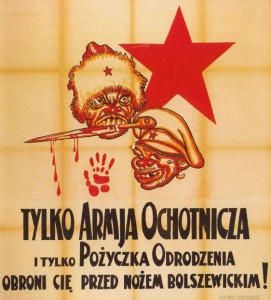Published on the six-month anniversary of Franciszek Herzog’s
death.
In 2012, shortly after my discovery in the US National
Archives, of the coded letters sent from Oflag 64, I spoke with an Associated
Press reporter working on the story of the declassified files. He wanted to see a copy of these materials,
and so I went to the AP offices near Hudson Yards in New York. During the course of our meeting he mentioned
that the AP was also speaking to the son of one of the Katyń victims. Little did I know that this was Franciszek
Herzog, who had for years been actively been involved in the Związek Harcerstwa
Polskiego (ZHP - Polish Scouting) in the United States, and was one of its
mainstays.
Many members of Polonia in the United States were aware of
Franciszek Herzog’s engagement in Scouting, almost none, however, were aware of
his link to Katyń or more specifically of his attempts to have the US
government publicly confirm Soviet responsibility….
Franciszek Herzog, Jr. was the son of Captain Franciszek
Herzog.
Upon the invasion of Poland by the Soviet Union on September 17, 1939,
the Soviets began accumulating information about these prisoners as well as
their families. Thus, the prisoners were
allowed to write letters to their families, and received responses from
them. In this manner, the Soviets
garnered the home addresses of the prisoner’s families… As a result, on several days, in the early
morning hours of late winter and early spring of 1940, NKVD officers arrived at
the homes of these families and informed them that they had two hours to
prepare for travel. These families,
consisting of women and children, as well as some elderly men and women, were
loaded into boxcars and travelled into the depths of the USSR – to various of
the Soviet ‘stans’ where they were offloaded, either in kolkhozes or in open
fields. They were then told they were to
work as lumberjacks (one can just imagine these women wielding handsaws) or in
the fields. In most cases, they first
shared a room with locals (if there were any) and then built peat sod huts,
which were half submerged in the ground.
These were the conditions that faced Franciszek Herzog’s
mother and her children. His mother did
not survive this period and young Franciszek, together with his older sibling,
managed to join the group of orphans whom the Polish delegates had located at
various orphanages throughout the Soviet Union, and others who had arrived at
Jangi Jul on their own. These children
as well as mothers with children were then transported out of the Soviet Union
across the Caspian Sea to Pahlevi, Iran and dispersed throughout the world
(Kenya, Rhodesia, South Africa, New Zealand, Australia and Mexico were some of
the nations were these refugee women and children were sent) and one small
group of children was hosted by a Maharajah in India. One of the members of this last group was
Franciszek Herzog.
His route then led to the Middle East and Great Britain,
where he completed his studies and having immigrated to the United States, he
settled in Connecticut.
As readers, you are now asking – “why is Franciszek Herzog important enough to
write about and why is he a singular Child of Katyń…”
By 1990 Gorbachev had delivered what was referred to as File
No. 1, and which had lain in the safe of the Communist Party Secretary in
Moscow since 1940. That file contained
the document signed by all the Party Presidium members and which condemned the
Katyń, Ostashkov and Starobielsk prisoners to death.
The fact is, that the United States clearly knew that the
Soviets had committed the crime. The Madden Committee had reached that
conclusion based on its hearings in 1951 and 1952.
As a naturalized citizen of the USA, Franciszek Herzog
believed that he had the right to demand accountability from the President of
the United States and the Department of State for the actions and statements of
the Government of the United States.
Although there were any number of children and widows of Katyń victims
residing in the US, none of them felt confident enough to demand such
accountability.
Franciszek Herzog did demand accountability, and the letters
he sent to the Department of State over a period of months remained unanswered,
until he wrote a final letter in which he advised the Department that he was now
including Senator Dodd of Connecticut in the correspondence. At that point, the Department of State did
proceed to prepare a flimsy response stating it had not been clear who had
committed the Massacre.
These documents – both Franciszek Herzog’s letters demanding
an apology from the Department of State to the Families of the Katyń Victims as
well as the quasi-throttled response with its weak excuses were part of the
material declassified (yes, his letters were classified) and the Associated
Press included this as the lead to its story on this declassification and
posting.
The main photograph in the story was a closeup of Franciszek
Herzog holding a photo of his father next to his face appeared in thousands of newspapers throughout the world.
http://www.timesofisrael.com/newly-declassified-memos-show-us-hushed-up-1940-soviet-mass-murder/
Although Franciszek Herzog’s efforts to have the US confirm Soviet
guilt were never acknowledged by the Polish government – during his lifetime, they were acknowledged after his death. He was awarded the Officers Cross of the Order of Merit of the Republic of Poland for his efforts in propagating the truth about Katyn and for his work with Polish Scouting in the US.
http://www.lex.pl/mp-akt/-/akt/m-p-2017-343?refererPlid=52516
Franciszek
Herzog died on February 3, 2017.


